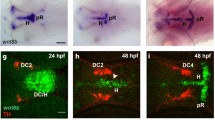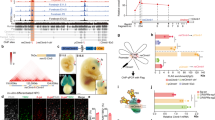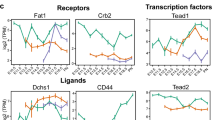Abstract
The floor plate, an essential ventral midline organizing center that produces the morphogen Shh, has distinct properties along the neuraxis. The neurogenic potential of the floor plate and its underlying mechanisms remain unknown. Using Shh as a driver for lineage analysis, we found that the mouse midbrain, but not the hindbrain, floor plate is neurogenic, giving rise to dopamine (DA) neurons. Distinct spatiotemporal Shh and Wnt expression may distinguish the neurogenetic potential of these structures. We discovered an inhibitory role for Shh: removal of Shh resulted in neurogenesis from the hindbrain midline and, conversely, high doses of Shh inhibited proliferation and DA neuron production in midbrain cultures. We found that Wnt/beta-catenin signaling is necessary and sufficient for antagonizing Shh, DA progenitor marker induction and promotion of dopaminergic neurogenesis. These findings demonstrate how the dynamic interplay of canonical Wnt/beta-catenin signaling and Shh may orchestrate floor plate neurogenesis or a lack thereof.
This is a preview of subscription content, access via your institution
Access options
Subscribe to this journal
Receive 12 print issues and online access
$209.00 per year
only $17.42 per issue
Buy this article
- Purchase on Springer Link
- Instant access to full article PDF
Prices may be subject to local taxes which are calculated during checkout






Similar content being viewed by others
References
Placzek, M. & Briscoe, J. The floor plate: multiple cells, multiple signals. Nat. Rev. Neurosci. 6, 230–240 (2005).
Fuccillo, M., Joyner, A.L. & Fishell, G. Morphogen to mitogen: the multiple roles of hedgehog signaling in vertebrate neural development. Nat. Rev. Neurosci. 7, 772–783 (2006).
Kittappa, R., Chang, W.W., Awatramani, R.B. & McKay, R.D. The foxa2 gene controls the birth and spontaneous degeneration of dopamine neurons in old age. PLoS Biol. 5, e325 (2007).
Ono, Y. et al. Differences in neurogenic potential in floor plate cells along an anteroposterior location: midbrain dopaminergic neurons originate from mesencephalic floor plate cells. Development 134, 3213–3225 (2007).
Bonilla, S. et al. Identification of midbrain floor plate radial glia-like cells as dopaminergic progenitors. Glia 56, 809–820 (2008).
Harfe, B.D. et al. Evidence for an expansion-based temporal Shh gradient in specifying vertebrate digit identities. Cell 118, 517–528 (2004).
Patten, I., Kulesa, P., Shen, M.M., Fraser, S. & Placzek, M. Distinct modes of floor plate induction in the chick embryo. Development 130, 4809–4821 (2003).
Epstein, D.J., McMahon, A.P. & Joyner, A.L. Regionalization of Sonic hedgehog transcription along the anteroposterior axis of the mouse central nervous system is regulated by Hnf3-dependent and Hnf3-independent mechanisms. Development 126, 281–292 (1999).
Scherz, P.J., McGlinn, E., Nissim, S. & Tabin, C.J. Extended exposure to Sonic hedgehog is required for patterning the posterior digits of the vertebrate limb. Dev. Biol. 308, 343–354 (2007).
Ye, W., Shimamura, K., Rubenstein, J.L., Hynes, M.A. & Rosenthal, A. FGF and Shh signals control dopaminergic and serotonergic cell fate in the anterior neural plate. Cell 93, 755–766 (1998).
Kele, J. et al. Neurogenin 2 is required for the development of ventral midbrain dopaminergic neurons. Development 133, 495–505 (2006).
Andersson, E., Jensen, J.B., Parmar, M., Guillemot, F. & Bjorklund, A. Development of the mesencephalic dopaminergic neuron system is compromised in the absence of neurogenin 2. Development 133, 507–516 (2006).
Echelard, Y. et al. Sonic hedgehog, a member of a family of putative signaling molecules, is implicated in the regulation of CNS polarity. Cell 75, 1417–1430 (1993).
Geng, X. et al. Haploinsufficiency of Six3 fails to activate Sonic hedgehog expression in the ventral forebrain and causes holoprosencephaly. Dev. Cell 15, 236–247 (2008).
Echelard, Y., Vassileva, G. & McMahon, A.P. Cis-acting regulatory sequences governing Wnt-1 expression in the developing mouse CNS. Development 120, 2213–2224 (1994).
Zervas, M., Millet, S., Ahn, S. & Joyner, A.L. Cell behaviors and genetic lineages of the mesencephalon and rhombomere 1. Neuron 43, 345–357 (2004).
Prakash, N. et al. A Wnt1-regulated genetic network controls the identity and fate of midbrain-dopaminergic progenitors in vivo. Development 133, 89–98 (2006).
Castelo-Branco, G. et al. Differential regulation of midbrain dopaminergic neuron development by Wnt-1, Wnt-3a and Wnt-5a. Proc. Natl. Acad. Sci. USA 100, 12747–12752 (2003).
McMahon, A.P. & Bradley, A. The Wnt-1 (int-1) proto-oncogene is required for development of a large region of the mouse brain. Cell 62, 1073–1085 (1990).
Blaess, S., Corrales, J.D. & Joyner, A.L. Sonic hedgehog regulates Gli activator and repressor functions with spatial and temporal precision in the mid/hindbrain region. Development 133, 1799–1809 (2006).
Wrobel, C.N., Mutch, C.A., Swaminathan, S., Taketo, M.M. & Chenn, A. Persistent expression of stabilized beta-catenin delays maturation of radial glial cells into intermediate progenitors. Dev. Biol. 309, 285–297 (2007).
Hynes, M. et al. Induction of midbrain dopaminergic neurons by Sonic hedgehog. Neuron 15, 35–44 (1995).
Andersson, E. et al. Identification of intrinsic determinants of midbrain dopamine neurons. Cell 124, 393–405 (2006).
Bayly, R.D., Ngo, M., Aglyamova, G.V. & Agarwala, S. Regulation of ventral midbrain patterning by Hedgehog signaling. Development 134, 2115–2124 (2007).
Manning, L. et al. Regional morphogenesis in the hypothalamus: a BMP-Tbx2 pathway coordinates fate and proliferation through Shh downregulation. Dev. Cell 11, 873–885 (2006).
Dessaud, E. et al. Interpretation of the sonic hedgehog morphogen gradient by a temporal adaptation mechanism. Nature 450, 717–720 (2007).
Ahn, S. & Joyner, A.L. Dynamic changes in the response of cells to positive hedgehog signaling during mouse limb patterning. Cell 118, 505–516 (2004).
Alvarez-Medina, R., Cayuso, J., Okubo, T., Takada, S. & Marti, E. Wnt canonical pathway restricts graded Shh/Gli patterning activity through the regulation of Gli3 expression. Development 135, 237–247 (2008).
Lei, Q. et al. Wnt signaling inhibitors regulate the transcriptional response to morphogenetic Shh-Gli signaling in the neural tube. Dev. Cell 11, 325–337 (2006).
Lagutin, O.V. et al. Six3 repression of Wnt signaling in the anterior neuroectoderm is essential for vertebrate forebrain development. Genes Dev. 17, 368–379 (2003).
McKay, R. & Kittappa, R. Will stem cell biology generate new therapies for Parkinson's disease? Neuron 58, 659–661 (2008).
Soriano, P. Generalized lacZ expression with the ROSA26 Cre reporter strain. Nat. Genet. 21, 70–71 (1999).
Harada, N. et al. Intestinal polyposis in mice with a dominant stable mutation of the beta-catenin gene. EMBO J. 18, 5931–5942 (1999).
Brault, V. et al. Inactivation of the beta-catenin gene by Wnt1-Cre–mediated deletion results in dramatic brain malformation and failure of craniofacial development. Development 128, 1253–1264 (2001).
Lewis, P.M. et al. Cholesterol modification of sonic hedgehog is required for long-range signaling activity and effective modulation of signaling by Ptc1. Cell 105, 599–612 (2001).
Awatramani, R., Soriano, P., Rodriguez, C., Mai, J.J. & Dymecki, S.M. Cryptic boundaries in roof plate and choroid plexus identified by intersectional gene activation. Nat. Genet. 35, 70–75 (2003).
Farago, A.F., Awatramani, R.B. & Dymecki, S.M. Assembly of the brainstem cochlear nuclear complex is revealed by intersectional and subtractive genetic fate maps. Neuron 50, 205–218 (2006).
Acknowledgements
We thank C. Tabin for Shh::cre mice and Shh cDNA; M. German for antibody to Lmx1a; T. Muller and C. Birchmeier for antibody to Lmx1b; D. Anderson for antibody to Ngn2; T. Edlund for antibodies to Gbx2; and A. Klar for the Spon1l cDNA. We thank A. Chenn for supplying Ctnnb1 mouse strains. We thank J. Kessler for suggestions. R.B.A was supported by the Dana Foundation and the American Parkinson's Disease Association. M.J. was supported by the Parkinson's Disease Foundation.
Author information
Authors and Affiliations
Contributions
M.J. designed and conducted the experiments, prepared all of the figures and participated in writing the manuscript. B.A.Y. and A.M.A. helped to characterize various conditional mutants. R.K., W.W.C. and R.D.G.M. performed the in vitro analyses and provided useful discussions. M.M.T. provided the stabilized Ctnnb1 strain. R.B.A. supervised the study and wrote the manuscript.
Corresponding author
Supplementary information
Supplementary Text and Figures
Supplementary Figures 1–6 (PDF 1063 kb)
Rights and permissions
About this article
Cite this article
Joksimovic, M., Yun, B., Kittappa, R. et al. Wnt antagonism of Shh facilitates midbrain floor plate neurogenesis. Nat Neurosci 12, 125–131 (2009). https://doi.org/10.1038/nn.2243
Received:
Accepted:
Published:
Issue Date:
DOI: https://doi.org/10.1038/nn.2243
This article is cited by
-
A novel mutation in intron 1 of Wnt1 causes developmental loss of dopaminergic neurons in midbrain and ASD-like behaviors in rats
Molecular Psychiatry (2023)
-
An optimized Nurr1 agonist provides disease-modifying effects in Parkinson’s disease models
Nature Communications (2023)
-
Spotting-based differentiation of functional dopaminergic progenitors from human pluripotent stem cells
Nature Protocols (2022)
-
Wnt/β-catenin signaling promotes neurogenesis in the diencephalospinal dopaminergic system of embryonic zebrafish
Scientific Reports (2022)
-
Molecular Insights into NR4A2(Nurr1): an Emerging Target for Neuroprotective Therapy Against Neuroinflammation and Neuronal Cell Death
Molecular Neurobiology (2019)



